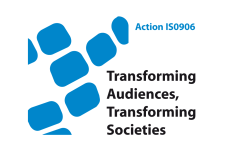- About the Action
- Events
- PhD workshop - Ljubljana 2014
- Action Open Conference - Ljubljana 2014
- New Media and Participation conference - Istanbul 2013
- Belgrade meeting 2013
- Media literacy research and policy - Brussels 2013
- ICA Pre-Conference 2013
- Tampere meeting 2013
- Budapest workshop 2012
- Milan meeting 2012
- Brussels PhD workshop 2012
- Brussels Action workshop 2012
- London meeting 2011
- Zagreb Conference 2011
- Lisbon meeting 2010
- Affiliated events
- WG 1
- WG 2
- WG 3
- WG 4
- Cross-WG
- Output
Music television and youth culture in Austria and the US - A comparative audience study. Doctoral workshop "Fieldwork in Contemporary Audience Studies", Ljubljana, 8 February 2014
Kulterer, J. (2014). Music television and youth culture in Austria and the US - A comparative audience study. Doctoral workshop "Fieldwork in Contemporary Audience Studies", Ljubljana, 8 February 2014. .
Abstract: This PhD project aims at answering the question which relevance former music television channels and icons of popular culture like MTV have for adolescents and young adults today. The main question is if MTV and similar channels are still relevant for youth culture in times of YouTube&Co. and how adolescents use and watch the content that is available in their program. As music television does no longer just air music videos but nowadays primarily TV shows that are targeted at a young audience, another goal is to find out how adolescents watch these shows with regard to their individual lebenswelt. As MTV’s content can be classified as transcultural, the project is designed as a comparative audience study, comparing the use of MTV among adolescents and young adults in Austria and the U.S. After looking into the history and recent developments in the music television business, which is the first part of the thesis, an audience study is at the core of the project. The methodological design of the study is a qualitative one, using focus groups and in-depth interviews as the main methods for data collection; a quantitative screening questionnaire was used in advance in order to find potential focus group participants and interview partners. The data collection phase in Austria was completed in June 2013, the data collection in the U.S. is currently in process and will be completed by September 2013. Questions and problems that arise from experiences in the field are how you deal with sampling problems e.g. such as interesting interview partners who do not want to participate, logistic problems when organizing focus groups and other unexpected developments. How flexible is qualitative research allowed to be when it comes to sampling and when do you know how much is enough? In addition to the basic problems, the country comparison presents other problems such as sampling in an unknown environment with limited time at hand, logistic and communicative problems and when looking at the later data analysis, the comparison of data within the theoretical framework of transcultural communication. How can you deal with a very complex set of qualitative data that is collected in two very different environments in which sampling was carried out under different circumstances and was sometimes affected by outer circumstances and pragmatic reasons like limited financial resources, limited time etc.? See the report in attachment to this webpage.

